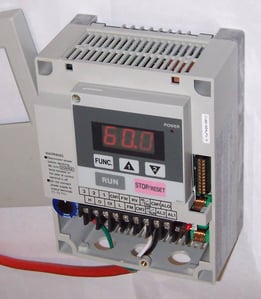There is a lot of hype about using variable frequency drives (VFDs) to control motors, both pro and con. On the one hand, they can provide large energy savings. On the other, they can damage the motors they control, and other equipment. Many of the arguments for and against deal with extreme examples, and there are not a lot of balanced considerations out there. motorsatwork.com has two good, unbiased articles on this: "Does every motor need a drive? Three questions to ask before buying another VFD" and "Does every motor need a drive? When NOT to use a VFD".
It's important to realize that the question is not, "Are VFDs good or bad?" The  question is, "Does it make sense to control this motor, in this situation, with a VFD?" You need to ask this question about every motor you consider a VFD for. Here are some things to consider when you answer that question.
question is, "Does it make sense to control this motor, in this situation, with a VFD?" You need to ask this question about every motor you consider a VFD for. Here are some things to consider when you answer that question.
You should use a drive if...
- Your application requires precise control. If you need smooth control, or for multiple motors to act in sync, a drive can do that.
- Your application involves frequent starts and stops, like some conveyor applications. VFDs can act as soft starters, and smoothly ramp their motors up to the desired speed. On-line power, motors start at full speed, causing mechanical stress and destructive inrush currents.
- Your application has a variable load. This comes up a lot in HVAC and pumping. VFDs can run motors at reduced speed, saving lots of energy in variable torque/power applications.
- You are currently running online power with a mechanical throttle. Running a motor at full speed and throttling the output is like driving with one foot on the gas and one on the brake. It's hugely wasteful. Switching to VFD operations will save significant energy and money.
You should not use a drive if...
- The motor's load is constant, and its output is unrestricted. If the motor is running at full speed with no damping or throttling, you won't save any energy by switching to a VFD. In fact, you would actually lose some efficiency. VFDs are not 100% efficient themselves. And not all of the power they put out is actually usable because it contains harmonics. This also adds to losses.
- Your application needs very low or very high speeds. Overly low speeds can cause overheating; high speeds cause mechanical damage. Instead of a drive, you should use a gearbox or other converter.
- Your motor is old. Motors from before the early 2000s are unable to stand up to VFD output. They will overheat at low speeds or their insulation will fail. Newer motors are designed to withstand VFDs' voltage pulses. (Provided they have shaft grounding rings, and possibly insulated bearings.) Additionally, since motor efficiencies are higher now, it might make sense to replace the old motor and get a VFD.
- You have power quality issues. VFDs can exacerbate existing problems with harmonics, voltage sag, and assorted transients. (In VFDs' defense: they do improve power factor.)
- The VFD and motor cannot be located close enough together. If the motor and drive are too far apart, the motor will be at higher risk of electrical damage. Manufacturers' recommendations vary from 100 to 250 feet maximum. (Line reactors may mitigate this effect.)
So there you have it! If you do decide that VFD control does make sense, be aware that VFDs create motor shaft voltage that causes electrical bearing damage and premature failure. In motors under 100 hp, an AEGIS® Shaft Grounding Ring will protect the bearings by bleeding off shaft voltage before it can arc through the bearings. In larger motors, circulating bearing currents are also a problem, so the best practice is to install an AEGIS ring and insulate the bearing at the opposite end of the motor from the ring.
AEGIS Rings also come with a 2-year extended warranty against bearing fluting damage. No other form of protection against VFD-caused bearing damage offers a warranty like this.

![]() To learn more about AEGIS shaft grounding and best practices for electrical bearing protection, sign up for a training. We offer monthly live training webinars, and - pandemic restrictions permitting - we can also visit your facility to review your exact application.
To learn more about AEGIS shaft grounding and best practices for electrical bearing protection, sign up for a training. We offer monthly live training webinars, and - pandemic restrictions permitting - we can also visit your facility to review your exact application.


